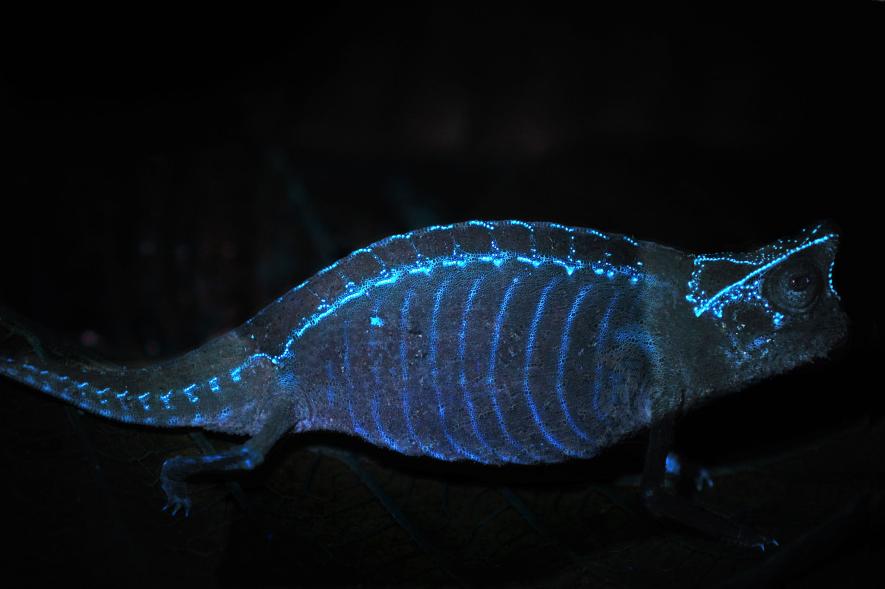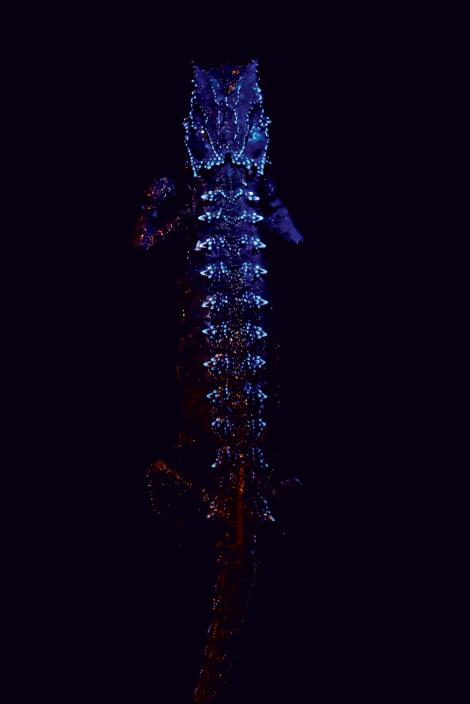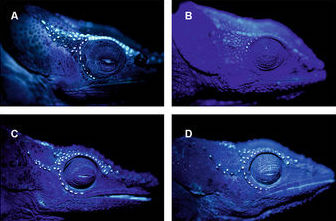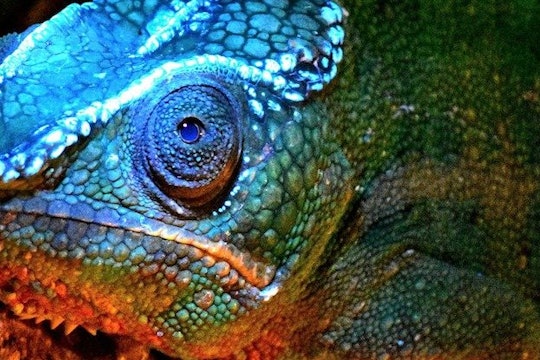Chameleons do more than change color – their bones glow in the dark
Famous for camouflage, their visual communication turns out to run even deeper
Hump-backed and slow, chameleons sway like leaves as they creep along branches. Their coned, protruding eyes scan their environment, searching for prey. They can move and focus each eye independently, looking two ways at once, or locking both eyes onto an insect before they strike with a sticky, missile-like tongue. The world must look very different to a chameleon.
Chameleon lives are oriented around their excellent vision, which they use not only to target prey and avoid predators, but to read covert signals written on the bodies of other chameleons. We’re still learning exactly how the chameleon has such an impressive command of color, but have long observed chameleons changing the color and skin patterns to respond to their environment and to express their moods in sophisticated displays.
In 2014, researchers at the University of Geneva reported that in addition to mobile pigments, chameleons also had shards of guanine nanocrystals embedded below their skin. When excited, chameleons change the spacing of these crystals, which affects how light moves through them, and in turn adjusts the color produced by the pigments. It’s like each chameleon has a prism under its skin.
These masters of disguise have been keeping another secret from us: they glow. Late last year, David Prötzel, a PhD student and lead author of a paper with colleagues at a slew of German and Dutch institutions, described how chameleons are on a very exclusive list of land-dwelling vertebrates – including some frogs, marine turtles, and parrots – that have natural fluorescence abilities. But true to form, chameleons found a way to glow that is unique: they are the first known animals that use their bones to glow.
For chameleons, beauty is more than skin deep.

To reveal their glowing patterns, Prötzel and his colleagues photographed living lizards in their habitats and recently preserved specimens in museums under UV light. Chameleons are flamboyant even in the dark, illuminated by pinpricks of deep blue and purple light, which traces the complex architecture of their skull – the ridges and sharp edges, crests, bumps, and peaks. The sheer intricacy of the patterns puzzled the scientists, until they peeled back the layers of the chameleon’s anatomy with micro-computed tomography, a technique that create 3D X-ray images of the skeleton on the microscopic level.
A chameleon’s body is ornamented with bumps, called tubercules, that are actually projections of their skeleton. They look impressive, and are generally more extravagant in rowdy males than in females. By matching these bumps with the glowing pattern, the team concluded that the bony tubercles were responsible.
Bone has been known to naturally fluoresce under UV light since the 1960s, and forensic researchers have used this phenomenon for decades. But the reason chameleons glow under blacklight and we do not is that the tubercules push aside all but the topmost layer of skin, including the dermis that contains the color-producing chromatophores and melanophores. This leaves a kind of "window" of skin over the bone, nearly transparent and thin enough to see its natural glow. This layer of skin also gives the glow its color, acting as a filter that nudges the fluorescence toward the blue end of the color spectrum. Chameleons are the first animals known to co-opt this natural property of bone as part of their coloration.
Looming over the finding is another question: why do they glow?

Asking why animals look, work, and act the way that they do is perhaps the central question in evolutionary biology. To approach it, scientists often take a few minutes to take the lay of the land and try to identify common patterns across many species. One unusual phenomenon – say, a glowing lizard – in one or two species is a curiosity. Seeing it appear in multiple species and across families suggests that the trait means something evolutionarily interesting to it.
Natural history collections like those at the Zoologische Staatssammlung München (in Munich, Germany), the Museo Regionale di Scienze Naturali (Torino, Italy), and the Senckenberg Museum (Frankfurt, Germany), are ideal for these sort of broad, evolutionary questions, because they have hundreds of specimens, often including rare or extinct species, waiting to be poked and prodded by researchers.
Digging deep into the reptiles collections, Prötzel and his team surveyed the fluorescent ability of over 50 species of chameleons native to Madagascar and parts of Africa, a total of more than 300 individual specimens. They discovered that eight of 12 groups of closely-related species, called genera, displayed at least some bone-based fluorescence. Two out of three ain’t bad, especially for evolutionary biology.
So bone-based fluorescence is widespread among chameleon lineages. The tricky part was rationalizing why chameleons, already so good at silently expressing their feelings through colour, needed to add some glitter and shine to the conversation. Perhaps, the researcher suggested, this bone-based fluorescence is a clandestine extension of the chameleon’s visual communication system, already highly developed.

Having a secondary signaling system actually makes a lot of sense – it would mean that chameleon visual communication doesn’t go silent after dark, and that they can continue to communicate with each other far into the night. The bone glow has another advantage, too: many animals, including humans, can’t see UV light as chameleons can. They are effectively blowing dogwhistles at each other, sending messages only other chameleons can hear.
Interestingly, the glow is typically more prominent in chameleons that live in shady, humid, forest habitats than those in open, dry grasslands. The physics of UV light work in favor of forest-dwelling chameleons: light with a short wavelength, like UV, scatters more in humid environments. This means that there is proportionally more UV light under the trees compared to open environments, and therefore chameleons under a canopy will shine brighter than those in a field. Perhaps the supercharged glow caused by the humid forest canopy has shaped the evolution of forest chameleons, giving them more intricate displays because they get more bang for their buck.
What exactly the chameleons are saying to each other is still a mystery. One hypothesis is that it’s all about impressing the girls, since male chameleons typically have more intricate tubercules, and the brightness of the glow may help male chameleons attract interested ladies. Even if we can't see with a chameleon's eyes, the scenario is fun to imagine. Pretend you’re a beautiful lady chameleon, and a suitor shuffles onto your branch – and promptly lights up the forest. Like, he literally glows. Who could resist?
Fluorescence is common in the marine environment – think of deep sea anglerfish or jellyfish– and we are quickly learning it’s much more common than we thought on land. It brings into question what else we may be missing because we weren’t looking hard enough, or under the right conditions. Who know's what other secrets Mother Nature has written out in invisible ink, waiting for just the right lighting?

